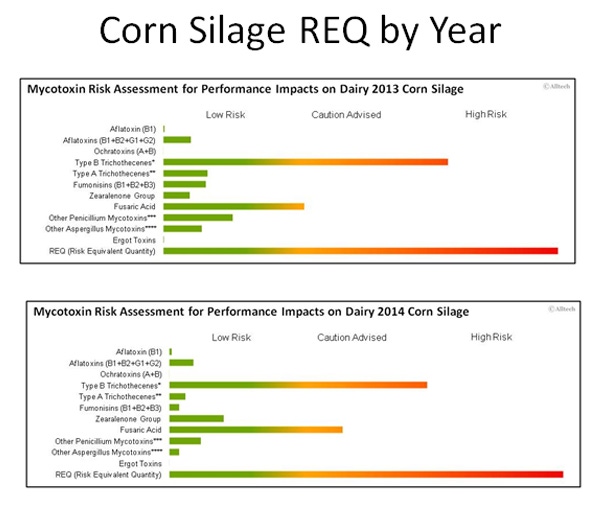Is your corn silage problem-free? Monitor it to make sure
At face value it would appear that the 2014 corn silage crop is getting better in storage, but we know that this cannot happen and it is still remaining at high risk.
April 7, 2015

Sponsored Content
Cool, wet weather can be a precursor for mold growth, which can lead to mycotoxin issues. Fusarium graminearum can produce a variety of mycotoxins and prefers high moisture and temperatures from 50 to 85 degrees Fahrenheit. In addition to the cool and wet growing season, many areas were wet late and harvest was delayed.
Corn silage samples at harvest were analyzed at Alltech’s Analytical Analysis Lab utilizing LC-MSMS technology that is ISO/IEC 17025:2005 accredited. The analysis found 6.83 mycotoxins per sample. Type B Trichothecenes, Deoxynivalenol (DON) and other DON group mycotoxins, had an average/sample of 2,087 ppb. Fusaric Acid, which can act synergistically with DON, had an average of 1.322 ppb. Zearalenone had an average/sample of 126.7 ppb showing levels in the average sample higher than in the past 2 years.
As we progress through the year and continue to look at corn silage samples, mycotoxin levels and the REQ (Risk Equivalent Quantity) or total mycotoxin risk in the corn silage continues to be high risk.
 70+ photos showcasing all types of cattle nutrition
70+ photos showcasing all types of cattle nutrition
Readers share their favorite photos of cattle grazing or steers bellied up to the feedbunk. See reader favorite nutrition photos here.
At face value it would appear that the 2014 corn silage crop is getting better in storage but we know that this cannot happen and it is still remaining at high risk. Mycotoxin molecules are very stable and what is in the crop at harvest will remain. What this does illustrate is that the 2014 crop is storing better to date. The winter has been cold and there has been less snow cover to insulate the stored silage. As the weather is warming in the spring, the mycotoxin levels and subsequent REQ can increase rapidly. This dictates that the corn silage should be continually monitored for increasing mycotoxin levels and cows closely watched for health and performance issues.
Find out more about this and other critical topics at the beef symposium May 17- 20 during Alltech’s REBELation, an event exploring innovation, inspiration and revolution. Join the conversation as we examine the next frontier in beef nutrition.
You might also like:
6 steps to low-input cow herd feeding
10 tips for keeping first-calf heifers in tip-top shape
Breed-back on first-calf heifers starts with nutrition
2015 Feed Compositon Tables | Know the nutritional value of your feed
You May Also Like


.png?width=300&auto=webp&quality=80&disable=upscale)
